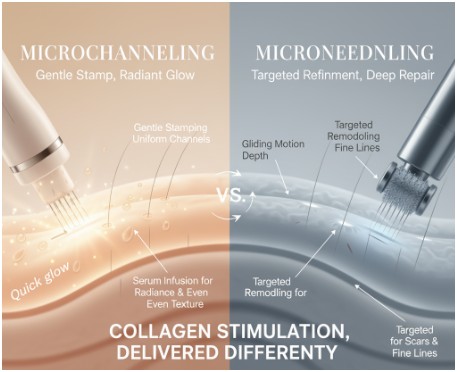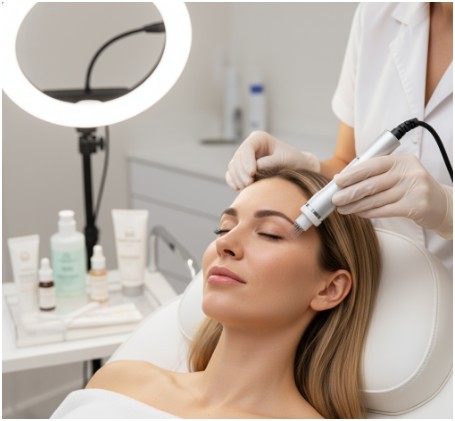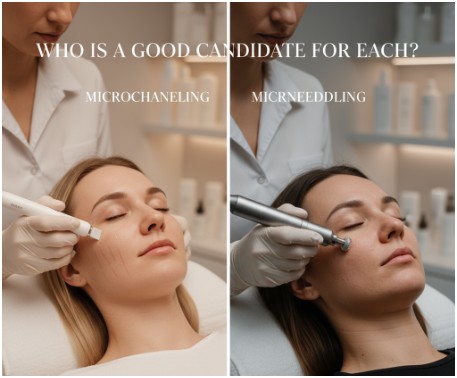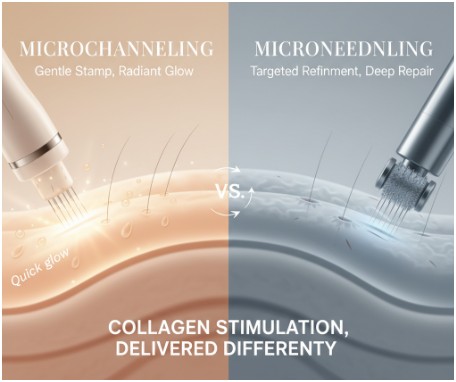If you’re deciding between these two skin treatments, you’re not alone. Both improve skin texture, reduce fine lines, and boost radiance by using controlled micro-injuries to stimulate collagen.
If you’re considering microchanneling in Utah, this guide will help you understand how each treatment works, what concerns they address, and how to choose the best option for your needs.
The Core Idea of Microchanneling vs. Microneedling: Collagen Stimulation, Delivered Differently

Both treatments are forms of collagen induction therapy, yet the tools and techniques differ. That difference affects comfort, downtime, and how quickly you notice a glow.
How microchanneling works
Microchanneling uses a gentle stamping technique to create uniform micro-channels in the skin. These channels ensure consistent depth, making it easy to treat larger areas.
Often paired with serum infusion, this method helps active ingredients penetrate deeply. After any redness fades, you’ll notice a smooth, refreshed appearance.
How microneedling works
Microneedling uses a device with tiny needles that create controlled micro-injuries. The depth can be adjusted to address textural issues like unevenness or mild scarring. The gliding method targets deeper layers where needed, ideal for thicker skin areas.
What Each Treatment Helps With
Both treatments are effective for skin rejuvenation, addressing fine lines, rough texture, enlarged pores, and dullness.
For an event-ready glow with minimal downtime, microchanneling’s infusion-based approach is a great option. If you’re targeting uneven texture or acne scars, microneedling’s adjustable depth offers more intensive remodeling.
For discoloration like hyperpigmentation, either treatment works well when paired with sun protection and gentle brightening products over time.
Comfort, Downtime, and Aftercare

Microchanneling feels like a quick, tolerable stamping sensation, with optional numbing based on the provider. Redness usually fades within a day or two.
Microneedling can feel more intense at greater depths, especially on sensitive areas, and typically involves numbing for comfort.
Afterward, mild pinkness and swelling are common for 1–3 days, sometimes followed by light flaking later in the week.
Great aftercare keeps results on track:
- Cleanse gently and keep skin hydrated.
- Avoid retinoids, AHAs, and BHAs for several days.
- Skip hot yoga, saunas, and heavy sweating for 24–48 hours.
- Hold off on makeup for at least 24 hours, or as your provider recommends.
- Wear broad-spectrum SPF daily and reapply; fresh skin needs extra care.
Healthy healing feels smoother when you treat your skin like a delicate fabric for the first few days.
When Results Show and How Many Sessions You May Need
Microchanneling gives your skin a noticeable glow within days by infusing products and creating even channels.
Over the next 2–4 weeks, you’ll notice improved texture and elasticity. Most treatment plans include 3–4 sessions spaced a month apart.
Microneedling stimulates collagen remodeling, with results appearing in 4–6 weeks. Typically, 3–6 sessions are recommended, spaced about a month apart. Occasional touch-ups a few times a year help maintain results.
Who Is a Good Candidate for Each?

- Microchanneling can be a great fit if you have mild texture changes, want a refreshed look fast, or prefer a treatment that leans lighter on recovery. Sensitive or reactive skin types often appreciate the controlled, uniform approach.
- Microneedling may be favored for thicker skin, visible textural roughness, or shallow pitted scars. Adjustable depths let trained providers tailor intensity, which can be useful for specific areas that need extra remodeling.
A professional consultation that reviews your history, current routine, and timing always clarifies the best path.
Safety Notes to Keep in Mind
Not all skin is ready for microneedling at any time. Active breakouts, open wounds, recent chemical peels, certain medications, or a history of keloid scarring need careful consideration.
Extra caution is also important during pregnancy and breastfeeding. Using sterile techniques, the right needle depth, and proper post-care are key for safe and effective results.
Choosing Confidently in Climate
High altitudes and dry air can damage your skin, and sunny seasons add the challenge of UV exposure. For hydration, many choose microchanneling, while microneedling is popular for improving texture.
A skilled provider can customize the treatment to suit your goals and environment, adjusting depth, spacing, and topical solutions as needed.
Quick Comparison: At A Glance
- Technique: Microchanneling stamps; microneedling glides.
- Feel: Microchanneling is typically brisk and even; microneedling intensity varies with depth.
- Downtime: Microchanneling often settles faster; microneedling can mean a few more recovery days at higher depths.
- Focus: Microchanneling shines for glow and product delivery; microneedling targets texture changes more aggressively when needed.
- Plan: Both usually involve a series, then maintenance.
Conclusion
Microchanneling and microneedling both boost collagen but differ in method, recovery, and focus. For a quick glow with minimal downtime, microchanneling is ideal.
For refining skin texture, microneedling provides adjustable depth for targeted results. Consult a licensed professional to assess your skin and create a personalized plan.




